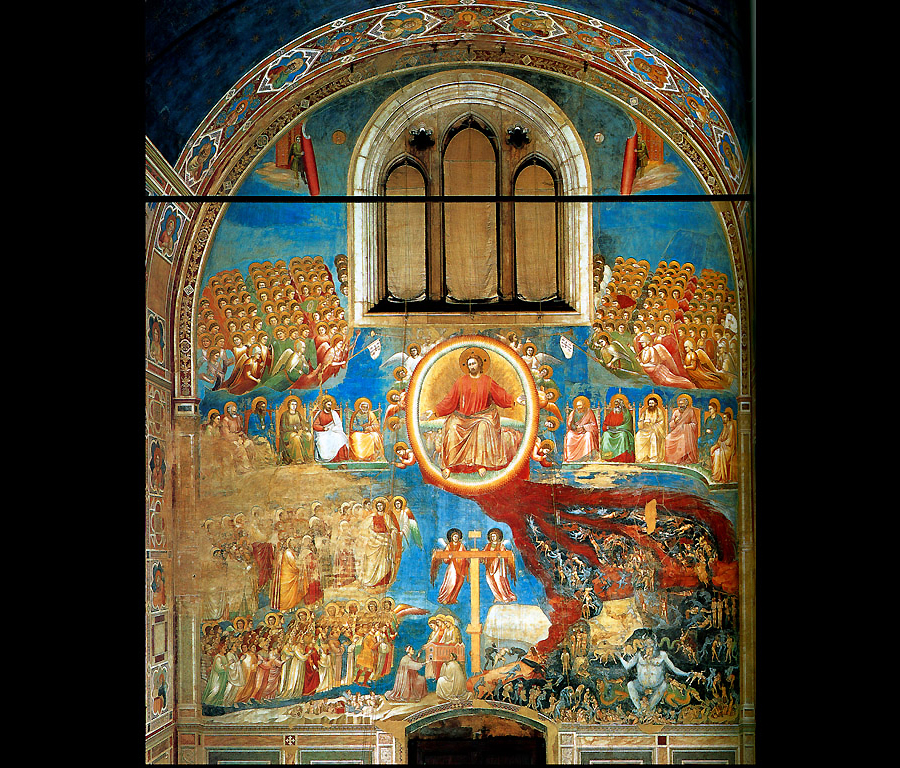His 1st appearance is believed to be this blue angel in this mosaic from Ravenna, Basilica of Sant'Apollinare Nuovo from the early 6th century AD. Blue was once associated with darkness because of this he has also been called the "angel of the night" as well as being on the side of the goats as it is said that Jesus will separate the followers (sheeps) from the non-believers(goats) but even though he wears this colour in this piece of art he is not a stand out character.

Another mosaic from Torcello from the 1100AD the creators not know but is thought they were Christians. the mosaic called "The Last Judgement", hell can be seen as part of the hierarchy of paradise for two reasons/ firstly this fiery tail stings off from a orb around Christ that leads to hell. As well as having two angels with long staffs pointing at heads with blue archangels holding them. in the far right of hell is a another blue man on a throne thought to either be the devil of a protector of Lucifer. In the Blue man's lap is a young child thought to be either Judas, the personification of hell or the devil but he properly named "the little master". Overall this mosaic shows that hell is part of god's divine plan in other words Lucifer is on gods side.

As the Christian church started to become more powerful they started to think about ways to keep Christians loyal and virtuous therefore there was a need for the devil to become someone to fear and this was reflected in the art work which took features from Pagan and Greek gods to make Satan. By doing this it also discriminated and demonising other religious gods and idols. Gods like "Bes" a Egyptian demon who protects against evil who was bulky and bearded as well as animalistic gods like "pan" for example.

 Giotto's painting of the Arena chapel in 1305 reflect on the mosaic from Torcello also called "the last Judgement" takes aspect from Pagan gods and animals with symbolism of sin and evil to create this monstrous, potbelly, blue devil surrounded by sin who seems to be enjoying the pain of the sinful. On the other hand compared to the rest of the chapel is painted with great beauty a with a sense of 3d making the paintings feel realistic; but when it comes to the look of Satan there is something abstract and flat about him this defiantly seen in the section called counselling Judas Lucifer is seen as a hairy demon but is flat compared to the other characters. This can reflection how the artist really saw the devil as a unimportant character.
Giotto's painting of the Arena chapel in 1305 reflect on the mosaic from Torcello also called "the last Judgement" takes aspect from Pagan gods and animals with symbolism of sin and evil to create this monstrous, potbelly, blue devil surrounded by sin who seems to be enjoying the pain of the sinful. On the other hand compared to the rest of the chapel is painted with great beauty a with a sense of 3d making the paintings feel realistic; but when it comes to the look of Satan there is something abstract and flat about him this defiantly seen in the section called counselling Judas Lucifer is seen as a hairy demon but is flat compared to the other characters. This can reflection how the artist really saw the devil as a unimportant character. Dante e Alighieri a friend of Giotto felt the same about the devil as a flat character and so he wrote an epic poem called Dante's inferno which shows the poets journey through the nine circles of hell the last circle where Satan is shows a very sympathetic Satan as he also receives punishment as well as the other sinners.
“He wept with all six eyes, and the tears fell over his three chins mingled with bloody foam. The teeth of each mouth held a sinner, kept as by a flax rake: thus he held three of them in agony."
this description also reminds the reader of Lucifer's previous beauty as a angel but reminds the reader mostly of all the sorrow in the world that Lucifer is going through as well as thinking about his mental state of mind. This epic poem then led on to influence over poets like John Milton's "Paradise Lost" where Lucifer's fall is also seen as sympathetic.
the last example of Lucifer's change in art come full-circle as the Limbourgs brothers illustrated the "tres Riches Heures" a manuscript containing a variety of religious events but the one we want to concentrate on is the illustration of "the fall of the rebel angels". once again the angels are depicted in a blue robes like in the 1st mosaic but with the beauty from the illustrations of Lucifer from "Paradise Lost". Satan looks terrified, distraught showing his humanity. But only two pages after another illustration of Lucifer is seen as a hideous demon being tortured and shows no enjoyment in this as if regretting his betrayal receiving his punishment knowing he was wrong. These two images just shows how the devil is like a split personality as there are two main ways to portray him as a figure of beauty and pity, the other as a hideous demon with the enjoyment of torture.
In conclusion being able to sympathise with Satan and see how virtuous he can be seen at the beginning of his story which can allow me to continue pursuing in his character to become a virtue. I will now look into virtues that can fit his character such as diligence and humility but stay away from his clear sins like pride and envy.







